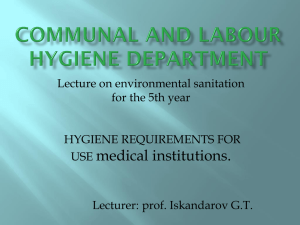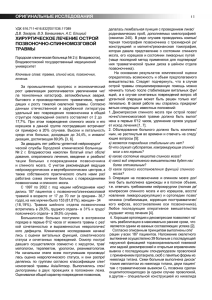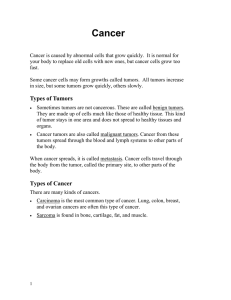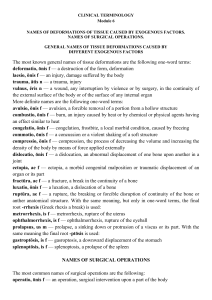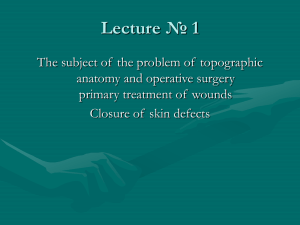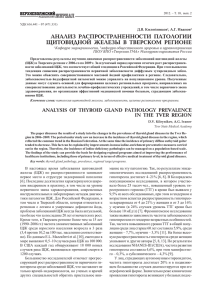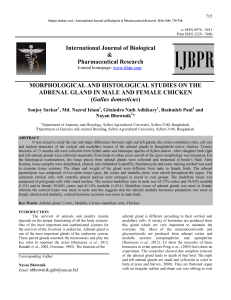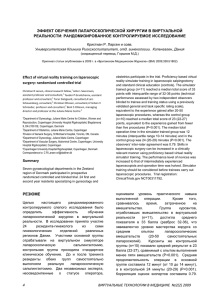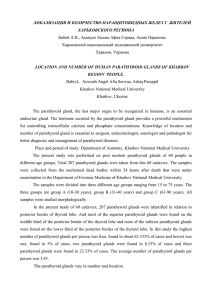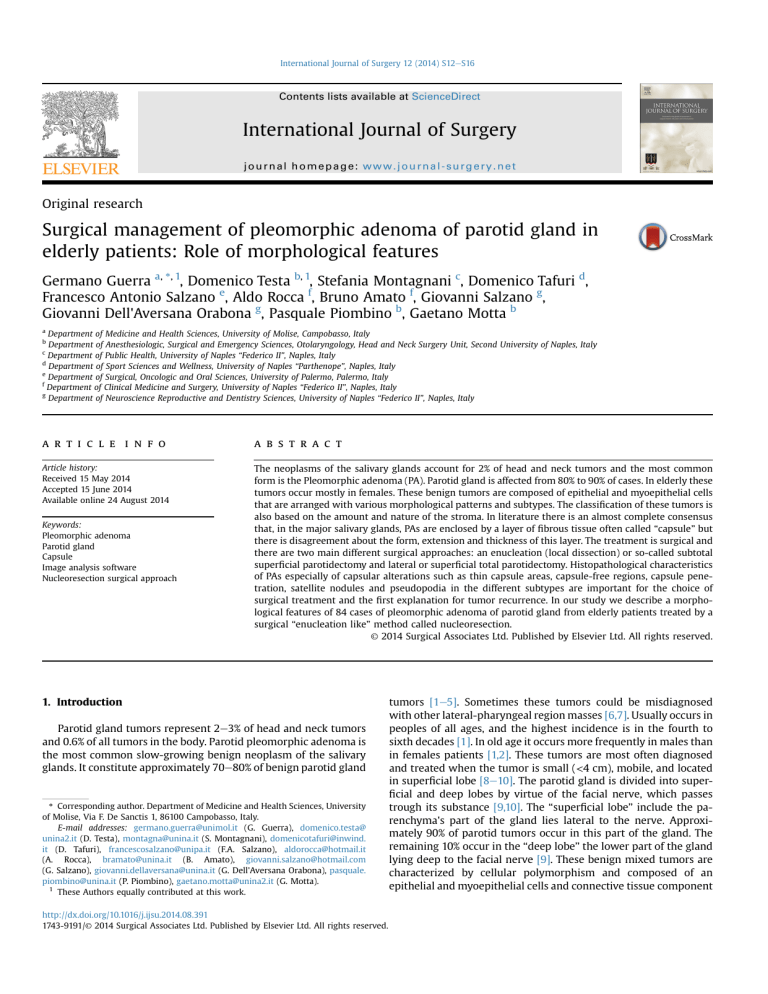
International Journal of Surgery 12 (2014) S12eS16 Contents lists available at ScienceDirect International Journal of Surgery journal homepage: www.journal-surgery.net Original research Surgical management of pleomorphic adenoma of parotid gland in elderly patients: Role of morphological features Germano Guerra a, *, 1, Domenico Testa b, 1, Stefania Montagnani c, Domenico Tafuri d, Francesco Antonio Salzano e, Aldo Rocca f, Bruno Amato f, Giovanni Salzano g, Giovanni Dell'Aversana Orabona g, Pasquale Piombino b, Gaetano Motta b a Department of Medicine and Health Sciences, University of Molise, Campobasso, Italy Department of Anesthesiologic, Surgical and Emergency Sciences, Otolaryngology, Head and Neck Surgery Unit, Second University of Naples, Italy Department of Public Health, University of Naples “Federico II”, Naples, Italy d Department of Sport Sciences and Wellness, University of Naples “Parthenope”, Naples, Italy e Department of Surgical, Oncologic and Oral Sciences, University of Palermo, Palermo, Italy f Department of Clinical Medicine and Surgery, University of Naples “Federico II”, Naples, Italy g Department of Neuroscience Reproductive and Dentistry Sciences, University of Naples “Federico II”, Naples, Italy b c a r t i c l e i n f o a b s t r a c t Article history: Received 15 May 2014 Accepted 15 June 2014 Available online 24 August 2014 The neoplasms of the salivary glands account for 2% of head and neck tumors and the most common form is the Pleomorphic adenoma (PA). Parotid gland is affected from 80% to 90% of cases. In elderly these tumors occur mostly in females. These benign tumors are composed of epithelial and myoepithelial cells that are arranged with various morphological patterns and subtypes. The classification of these tumors is also based on the amount and nature of the stroma. In literature there is an almost complete consensus that, in the major salivary glands, PAs are enclosed by a layer of fibrous tissue often called “capsule” but there is disagreement about the form, extension and thickness of this layer. The treatment is surgical and there are two main different surgical approaches: an enucleation (local dissection) or so-called subtotal superficial parotidectomy and lateral or superficial total parotidectomy. Histopathological characteristics of PAs especially of capsular alterations such as thin capsule areas, capsule-free regions, capsule penetration, satellite nodules and pseudopodia in the different subtypes are important for the choice of surgical treatment and the first explanation for tumor recurrence. In our study we describe a morphological features of 84 cases of pleomorphic adenoma of parotid gland from elderly patients treated by a surgical “enucleation like” method called nucleoresection. © 2014 Surgical Associates Ltd. Published by Elsevier Ltd. All rights reserved. Keywords: Pleomorphic adenoma Parotid gland Capsule Image analysis software Nucleoresection surgical approach 1. Introduction Parotid gland tumors represent 2e3% of head and neck tumors and 0.6% of all tumors in the body. Parotid pleomorphic adenoma is the most common slow-growing benign neoplasm of the salivary glands. It constitute approximately 70e80% of benign parotid gland * Corresponding author. Department of Medicine and Health Sciences, University of Molise, Via F. De Sanctis 1, 86100 Campobasso, Italy. E-mail addresses: [email protected] (G. Guerra), domenico.testa@ unina2.it (D. Testa), [email protected] (S. Montagnani), domenicotafuri@inwind. it (D. Tafuri), [email protected] (F.A. Salzano), [email protected] (A. Rocca), [email protected] (B. Amato), [email protected] (G. Salzano), [email protected] (G. Dell'Aversana Orabona), pasquale. [email protected] (P. Piombino), [email protected] (G. Motta). 1 These Authors equally contributed at this work. http://dx.doi.org/10.1016/j.ijsu.2014.08.391 1743-9191/© 2014 Surgical Associates Ltd. Published by Elsevier Ltd. All rights reserved. tumors [1e5]. Sometimes these tumors could be misdiagnosed with other lateral-pharyngeal region masses [6,7]. Usually occurs in peoples of all ages, and the highest incidence is in the fourth to sixth decades [1]. In old age it occurs more frequently in males than in females patients [1,2]. These tumors are most often diagnosed and treated when the tumor is small (<4 cm), mobile, and located in superficial lobe [8e10]. The parotid gland is divided into superficial and deep lobes by virtue of the facial nerve, which passes trough its substance [9,10]. The “superficial lobe” include the parenchyma's part of the gland lies lateral to the nerve. Approximately 90% of parotid tumors occur in this part of the gland. The remaining 10% occur in the “deep lobe” the lower part of the gland lying deep to the facial nerve [9]. These benign mixed tumors are characterized by cellular polymorphism and composed of an epithelial and myoepithelial cells and connective tissue component G. Guerra et al. / International Journal of Surgery 12 (2014) S12eS16 embedded in a stroma of mucoid, myxoid, chondroid or osteoid origin [11e15]. Macroscopically it has surrounding “capsule” from which it can be enucleated-often the treatment used in the past. Often these tumors do not have a true capsule but can press surrounding normal salivary gland, frequently having finger-like extensions into the normal tissues [16]. These and others histopathological characteristics are the main explanation for tumor recurrence after inappropriate surgical treatment. The instrumental examination used for planning the surgical treatment to be applied and for studying the relations of recurrence with glandular parenchyma were CT with contrast medium or MR of head and neck. In this context, the value of morphological findings obtained by fine needle aspiration cytology (FNAC) can be questioned [17e26]. Surgical management of pleomorphic adenoma 50 years ago consisted predominantly of local excision or “enucleation technique”, a procedure that yields recurrence rates from 20% to 45%. The hypothesis for recurrence of pleomorphic adenoma using this type of surgical approach is that microscopic portions of tumor perforate the capsule and are shared off resulting in a subtotal removal [27,28]. Nevertheless, some complications can be occurred during surgical procedure. The main complication is temporary/ permanent facial nerve paralysis that compromises quality of life. Various studies showed a positive relationship between the extent of parotid surgery and postoperative facial nerve function. Another relatively frequent complication is Frey syndrome/gustatory sweating. A further unwanted complication of surgical approaches in recurrent tumors is parotid cancer development. In literature patients treated by different surgical procedures showed in different percentages these dysfunctions [29e34]. The replacement of simple enucleation of tumor with other surgical approaches like: superficial parotidectomy (SP), total parotidectomy (TP), and extracapsular dissection (ECD) as treatment of choice reduced dramatically the incidence of tumor's recurrence and complications [35e37]. There is no hint of a remodeling of Ca2þ toolkit, that has been observed in other tumoral lesions, including renal cellular carcinoma [38e40], and prostate cancer [41], mielofibrosis [42], and used as target for selective molecular therapies. Actually there is a general consensus about relevance of adenoma “capsule”; in this paper we measured its thickness and try to demonstrate the precise relationship between this histopathologic feature, surgical management and tumor recurrence. 2. Material and methods Samples of PA affecting the major salivary gland from 84 patients were collected between 2002 and 2011. Patients with recurrent PA or history of any other parotid gland surgery were excluded from the study. According to epidemiologic data of elderly 54 patients were females (64.2%) and only 30 were males (35.7%). Mean age was 67.5 years ± 4.9 years SD. In 76 of 84 cases (90.4%) first diagnosis was performed, while in 8 cases (9.5%) recurrence occurred. All patients underwent ear, nose and throat (ENT) specialist examination, ultrasonography and preoperative fineneedle aspiration biopsy at Otolaryngology Department of Second University of Naples. A Nucleoresection surgical approach was performed in 76 patients (90.4%). In 3 patients (3.5%) and in 5 patients (5.9%) superficial parotidectomy and total parotidectomy respectively were used to remove the masses. After surgical procedures, specimens were fixed in 4% paraformaldehyde. Before dissecting the specimens for histopathological processing the surface of the parotid gland, which usually was protruded by the adenomas was inked with a specific color. We used India Ink color so it is feasible that minor capsular artifacts arose during fixation and cutting so the degree of invasion or capsular damage might have been underestimated. The inked specimens were dipped into Bouin S13 solution for 30 s to mordant the ink to the surface, thus minimizing smearing during dissection. The specimens were cut into a various number of slices of 4-mm thickness according to the tumor size. Slices were perpendicular to the long axis of the tumor nodule, which usually correspond to the long axis of the gland. The tip of the small tumor poles were cut perpendicular to the main slicing direction to obtain many transverse cuts of the tumor capsule of the poles. Thus, the slides were dehydrated in a graded series of alcohols and xylene and embedded in paraffin. Sections of 5-mm thickness were stained with Emaoxilin & Eosin. A Leitz Axiophot microscope (Leitz, Germany) equipped for microphotography was used for light microscopic observations. An advanced software for the analysis of images (Quantimet 520, Leica, Germany) was used to measure some characteristics of sections. Images were directly acquired by optic microscope at 20 enlargement using a specialized video camera (DC 200, Leica, Germany). The histologic examined areas were digitized and successively processed. The optic quality of these areas was optimized by modifying the brilliance and the contrast. The stained areas were highlighted by the program on the basis of their levels of gray and measured. This measurement was realized on 5 sections for each sample and six fields were analyzed per section. The mean value of measurement derived by the analysis of all areas in the 5 sections was reported. Sections were examined and measured by three independent observers. 3. Results In our series, cytological study had an excellent diagnostic value with a higher sensitivity in comparison with MRI scan. According to Seifert et al. original classification partially revised by Stennert et al., in 2001 our samples were graded in four types [11,12]. Type I comprised 13 patients (15.4%), type II comprised 44 patients (52.4%), type III included 18 subjects (21.4%) and finally 9 patients (10.7%) were assigned to type IV. Results of capsule measurement performed using analysis of images software are summarized in Table 1. Parenchyma-rich tumors showed a ticker capsule than in stroma-rich tumors. In our samples hypercellular PAs have a thick capsule (Fig. 1(A) and (B)). Hypocellular tumors have a thin capsule and constitute the most frequently encountered histological type in recurrence (Fig. 1(C) and (D)). In stroma rich tumors the largest amount of stromal differentiation were represented by myxomatous tissue followed by chondroid and mixed mucochondroid stroma. According to literature tumors of deep lobe have a thicker capsule than those located in the superficial lobe. Tumors pseudopodias or grow through capsular breaches to extend to adjacent parotid or adipose or other soft tissues. Pseudopodias or capsule bulges are considered as an additional factor in recurrence. Capsule dimensions and integrity represented a good tool to establish the better surgical technique. We used in 76 patients (90.4%) a surgical approach called nucleoresection (Fig. 2). In 3 patients (3.5%) and in 5 patients (5.9%) superficial parotidectomy and total parotidectomy Table 1 In this table are reported measures of capsule thickness and their relationship with tumor grading. Grading Tipo Tipo Tipo Tipo Tipo Tipo Tipo I (>8 mm < 25 mm) I (>25 mm) II (>8 mm < 25 mm) II (>25 mm) III (>8 mm < 25 mm) III (>25 mm) IV (>8 mm < 25 mm) Capsule thickness 215.6 211.8 221.3 219.7 255.5 223.6 229.6 mm mm mm mm mm mm mm S14 G. Guerra et al. / International Journal of Surgery 12 (2014) S12eS16 Fig. 1. Morphological features of capsule: hypercellular PA showing a thick capsule (A); hypercellular PA with a thick capsule marked using India Ink (B); hypercellular PA showing a thick capsule and a mixomatous stroma (C); hypercellular PA with a thick capsule and mixomatous and chondroid stromal tissue (Ematoxilin & Eosin stain. Original magnification 150). Fig. 2. Nucleoresection surgical technique (A and B: two different times of surgical procedure). respectively were used to remove the tumors. At a mean follow-up of 24 months no local recurrences have been described and no patients presented local complications in 76 patients undergone to surgery at first time. In 8 patients surgically treated for tumor recurrence using superficial (3 patients) or total parotidectomy (5 patients) complications occurred. After superficial parotidectomy one patient showed a Frey Syndrome while one patient treated with total parotidectomy showed a facial nerve branches little dysfunction. 4. Discussion Aging is accompanied by a decline in the healthy function of several organs in response to different mechanisms like oxidative stress [43e45]. PA is a slowly growing, usually demarcated, and mobile tumor occurring frequently in females elderly patients. It constitute approximately 40e60% of benign salivary gland tumors located in the superficial parotid gland lobe in about 80% of cases [1e5,46]. This benign tumor is characterized by 3 main morphological features. The capsule is the most relevant structural components of PA. The other two morphological features are parenchyma (tumor epithelial cells) and stroma [11e15,47]. The parenchymal/stromal ratio varies, and was used to classify these tumors in four types. Many Authors have been recognized parenchyma-rich and stroma-rich variants [11e15]. There is no consensus whether the capsule is newly formed structure or reflects pre-existing connective tissue compressed by the growing tumor. Morphologically, the capsule could be consist as thick, dense, fibrous tissue that may be discontinuous or absent or become invaded and even penetrated by a tumor. Correlation between capsular features and parenchymal/stromal ratio or the location of the tumor has been made. The capsule is usually 0.015e1.75-mm thick and it is thicker in parenchyma-rich tumors than in stroma-rich tumors. In our series of cases hypercellular PAs have a thick capsule while hypocellular tumors have a thin capsule and constitute the most frequently encountered histological type in recurrence [48e50]. Half to two thirds of stroma rich tumors show a variable/focal absence of the capsule. Tumors pseudopodias or bulge or grow through capsular breaches to extend to adjacent parotid or soft tissues. Where the capsule is absent, tumor invades adjacent parotid or adipose tissue either as a broad advancing front or as small mammillations bulging out from the main mass G. Guerra et al. / International Journal of Surgery 12 (2014) S12eS16 [48e50]. Observation of capsular features in PA naturally leads to consideration of the so-called tumor satellites [51]. In particular satellites could correspond with section profiles of extracapsular tumor extension; continuity with the main mass is outside of the plane of that section. These may be alternatively attributed to the multifocal/multicentric origin of PAs [51]. The instrumental examination used for diagnosis and to plan the best were CT with contrast medium or MR of head and neck. There is no general consensus about fine needle aspiration cytology (FNAC) which morphological findings could be useful to surgical treatment [17e26]. Almost all PAs can be effectively treated by surgical procedures. PAs, small, mobile, with a clearly observed capsule located in the superficial lobe/tail of the parotid gland can be removed by limited surgery with few complications. Some complications can be occurred during surgical procedure. The main complications are: temporary/permanent facial nerve, Frey syndrome/gustatory sweating and parotid cancer development. Patients treated by different surgical procedures can be affected by these dysfunctions. Superficial parotidectomy (SP), total parotidectomy (TP), and extracapsular dissection (ECD) replaced enucleation surgical technique [52e54]. Alternative really novel therapeutic approach might consist in injecting the patients with autologous endothelial progenitor cells, to accelerate tissue revascularization and prevent a surgical approach [55e59]. We used in our series of cases nucleoresection technique as surgical treatment of choice to reduce dramatically the incidence of tumor's recurrence and complications. Nucleoresection is an “enucleation like” minimal margin surgery utilizing a capsule margins as plane of dissection. In this technique, the removal of healthy parotid tissue compared with formal parotidectomy is limited, thus minimizing recurrence rate and complications such as facial nerve dysfunction and Frey syndrome. Our results suggest that nucleoresection surgical approach using capsule characteristics and other morphological features could be considered a suitable option for first time diagnosed patients, reducing significantly tumor recurrence and complications development. Nevertheless we need longer follow-up to draw conclusive results. Ethical approval Ethical approval was requested and obtained from the “Second University of Naples” ethical committee. Funding All Authors have no source of funding. Author contribution Germano Guerra: Participated substantially in conception, design, and execution of the study and in the analysis and interpretation of data; also participated substantially in the drafting and editing of the manuscript. Domenico Testa: Participated substantially in conception, design, and execution of the study and in the analysis and interpretation of data; also participated substantially in the drafting and editing of the manuscript. Stefania Montagnani: Participated substantially in the analysis and interpretation of data and revised the manuscript. Domenico Tafuri: Revised the manuscript. Francesco Salzano: Participated substantially in conception, design, and execution of the study and in the analysis and interpretation of data. Aldo Rocca: Participated substantially in the analysis and interpretation of data. S15 Bruno Amato: Revised the manuscript. Giovanni Salzano: Participated substantially in the analysis and interpretation of data. Giovanni Dell'Aversana Orabona: Revised the manuscript. Pasquale Piombino: Participated substantially in conception, design, and execution of the study and in the analysis and interpretation of data. Gaetano Motta: Participated substantially in conception, design, and execution of the study and in the analysis and interpretation of data; also participated substantially in the editing of the manuscript. Conflicts of interest All Authors have no conflict of interests. References [1] J.W. Eveson, R.A. Cawson, Salivary gland tumours. A review of 2410 cases with particular reference to histological types, site, age and sex distribution, J. Pathol. 146 (1985) 51e58. [2] R.H. Spiro, Salivary neoplasms: overview of a 35-year experience with 2,807 patients, Head Neck Surg. 8 (1986) 177e184. [3] C. Ungari, F. Paparo, W. Colangeli, G. Iannetti, Parotid glands tumours: overview of a 10-year experience with 282 patients, focusing on 231 benign epithelial neoplasms, Eur. Rev. Med. Pharmacol. Sci. 12 (5) (2008 SepeOct) 321e325. [4] M.G. Vigili, F. Sciarretta, A. Marzetti, F. Marzetti, The recurrent multifocal pleomorphic adenoma, Acta Otorhinolaryngol. Ital. 13 (1) (1993 JaneFeb) 31e42. [5] E. Stennert, C. Wittekindt, J.P. Klussmann, O. Guntinas-Lichius, New aspects in parotid gland surgery, Otolaryngol. Pol. 58 (1) (2004) 109e114. [6] A. Soscia, G. Guerra, M.P. Cinelli, D. Testa, V. Galli, V. Macchi, R. De Caro, Parapharyngeal ectopic thyroid: the possible persistence of the lateral thyroid anlage, Surg. Radiol. Anat. 26 (4) (2004) 338e343. [7] G. Guerra, M. Cinelli, M. Mesolella, D. Tafuri, A. Rocca, B. Amato, S. Rengo, D. Testa, Morphological, diagnostic and surgical features of ectopic thyroid gland: a review of literature, Int. J. Surg. 12 (2014). S1:S3-S11. [8] J.S. Wolf, A.N. Goldberg, D.C. Bigelow, Pleomorphic adenoma of the parotid, Am. Fam. Physician 56 (1) (1997 Jul) 185e192. [9] M.S. Harney, C. Murphy, S. Hone, M. Toner, C.V. Timon, A histological comparison of deep and superficial lobe pleomorphic adenomas of the parotid gland, Head Neck 25 (8) (2003 Aug) 649e653. [10] D.M. Fliss, R. Rival, P. Gullane, D. Mock, J.L. Freeman, Pleomorphic adenoma: a preliminary histopathologic comparison between tumors occurring in the deep and superficial lobes of the parotid gland, Ear Nose Throat J. 71 (6) (1992 Jun) 254e257. [11] G. Seifert, C. Brocheriou, A. Cardesa, et al., WHO International Histological Classification of Tumours. Tentative histological classification of salivary gland tumours, Pathol. Res. Pract. 186 (1990) 555e581. [12] E. Stennert, O. Guntinas-Lichius, J.P. Klussmann, G. Arnold, Histopathology of pleomorphic adenoma in the parotid gland: a prospective unselected series of 100 cases, Laryngoscope 111 (12) (2001 Dec) 2195e2200. €ren, E. Stauffer, Pleomorphic adenoma of the parotid gland: histo[13] P. Zba pathologic analysis of the capsular characteristics of 218 tumors, Head Neck 29 (8) (2007 Aug) 751e757. [14] M. Takahashi, K. Hokunan, T. Unno, Immunohistochemical study of basement membrane in pleomorphic adenomas of the parotid gland: comparison between primary treated tumor and recurrent tumor, Nippon Jibiinkoka Gakkai Kaiho 95 (11) (1992 Nov) 1759e1764. [15] M. Takahashi, M. Kumai, T. Kamito, M. Uehara, T. Unno, Clinico-pathological findings of recurrent pleomorphic adenomas of the parotid gland, Nippon Jibiinkoka Gakkai Kaiho 94 (4) (1991 Apr) 489e494. [16] A.J. Webb, J.W. Eveson, Pleomorphic adenomas of the major salivary glands: a study of the capsular form in relation to surgical management, Clin. Otolaryngol. Allied Sci. 26 (2) (2001 Apr) 134e142. [17] K. Ikeda, T. Katoh, S.K. Ha-Kawa, H. Iwai, T. Yamashita, Y. Tanaka, The usefulness of MR in establishing the diagnosis of parotid pleomorphic adenoma, Am. J. Neuroradiol. 17 (3) (1996 Mar) 555e559. [18] M. Ishibashi, S. Fujii, K. Kawamoto, K. Nishihara, E. Matsusue, K. Kodani, T. Kaminou, T. Ogawa, Capsule of parotid gland tumor: evaluation by 3.0 T magnetic resonance imaging using surface coils, Acta Radiol. 51 (10) (2010 Dec) 1103e1110. [19] N. Kakimoto, S. Gamoh, J. Tamaki, M. Kishino, S. Murakami, S. Furukawa, CT and MR images of pleomorphic adenoma in major and minor salivary glands, Eur. J. Radiol. 69 (3) (2009 Mar) 464e472. [20] I.C. De Bernardi, C. Floridi, A. Muollo, R. Giacchero, G.L. Dionigi, A. Reginelli, G. Gatta, V. Cantisani, R. Grassi, L. Brunese, G. Carrafiello, Vascular and interventional radiology radiofrequency ablation of benign thyroid nodules S16 [21] [22] [23] [24] [25] [26] [27] [28] [29] [30] [31] [32] [33] [34] [35] [36] [37] [38] [39] [40] G. Guerra et al. / International Journal of Surgery 12 (2014) S12eS16 and recurrent thyroid cancers: literature review, Radiol. Med. 119 (7) (2014 Jul) 512e520. F. Caranci, L. Brunese, A. Reginelli, M. Napoli, P. Fonio, F. Briganti, Neck neoplastic conditions in the emergency setting: role of multidetector computed tomography, Semin. Ultrasound CT MR 33 (5) (2012 Oct) 443e448. A. Reginelli, Y. Mandato, C. Cavaliere, N.L. Pizza, A. Russo, S. Cappabianca, L. Brunese, A. Rotondo, R. Grassi, Three-dimensional anal endosonography in depicting anal-canal anatomy, Radiol. Med. 117 (5) (2012 Aug) 759e771. , L. Brunese, M. Mangini, G. Carrafiello, F. Fontana, E. Cotta, M. Petulla C. Fugazzola, Ultrasound-guided thermal radiofrequency ablation (RFA) as an adjunct to systemic chemotherapy for breast cancer liver metastases, Radiol. Med. 116 (7) (2011) 1059e1066. A. Pinto, L. Brunese, S. Daniele, A. Faggian, G. Guarnieri, M. Muto, L. Romano, Role of computed tomography in the assessment of intraorbital foreign bodies, Semin. Ultrasound CT MRI 33 (5) (2012) 392e395. A. Pinto, L. Brunese, F. Pinto, R. Reali, S. Daniele, L. Romano, The concept of error and malpractice in radiology, Semin. Ultrasound CT MRI 33 (4) (2012) 275e279. S. Cappabianca, G. Colella, M.G. Pezzullo, A. Russo, F. Iaselli, L. Brunese, A. Rotondo, Lipomatous lesions of the head and neck region: imaging findings in comparison with histological type, Radiol. Med. 113 (5) (2008) 758e770. R. Becelli, M. Perugini, P. Mastellone, R. Frati, Surgical treatment of recurrences of pleomorphic adenoma of the parotid gland, J. Exp. Clin. Cancer Res. 20 (4) (2001 Dec) 487e489. M. Donati, L. Gandolfo, A. Privitera, G. Brancato, F. Cardi, A. Donati, Superficial parotidectomy as first choice for parotid tumours, Chir. Ital. 59 (1) (2007 JaneFeb) 91e97. R. Chilla, K. Schneider, M. Droese, Recurrence tendency and malignant transformation of pleomorphic adenomas, HNO 34 (11) (1986 Nov) 467e469. W.B. Fleming, Recurrent pleomorphic adenoma of the parotid, Aust. N. Z. J. Surg. 57 (3) (1987 Mar) 173e176. €o €, C. Silfverswa €rd, Recurrent primary G. Henriksson, K.M. Westrin, B. Carlso pleomorphic adenomas of salivary gland origin: intrasurgical rupture, histopathologic features, and pseudopodia, Cancer 82 (4) (1998 Feb 15) 617e620. D. Myssiorek, C.B. Ruah, R.L. Hybels, Recurrent pleomorphic adenomas of the parotid gland, Head Neck 12 (4) (1990 Jul-Aug) 332e336. K. Natvig, R. Søberg, Relationship of intraoperative rupture of pleomorphic adenomas to recurrence: an 11e25 year follow-up study, Head Neck 16 (3) (1994 MayeJun) 213e217. J. Paris, F. Facon, M.A. Chrestian, A. Giovanni, M. Zanaret, Recurrences of pleomorphic adenomas of the parotid: development of concepts, Rev. Laryngol. Otol. Rhinol. Bord. 125 (2) (2004) 75e80. O. Emodi, I.A. El-Naaj, A. Gordin, S. Akrish, M. Peled, Superficial parotidectomy versus retrograde partial superficial parotidectomy in treating benign salivary gland tumor (pleomorphic adenoma), J. Oral Maxillofac. Surg. 68 (9) (2010 Sep) 2092e2098. M. Fukushima, M. Miyaguchi, T. Kitahara, Extracapsular dissection: minimally invasive surgery applied to patients with parotid pleomorphic adenoma, Acta Otolaryngol. 131 (2011) 653e659. K.H. Lam, W.I. Wei, H.C. Ho, C.M. Ho, Whole organ sectioning of mixed parotid tumors, Am. J. Surg. 160 (4) (1990 Oct) 377e381. S. Dragoni, U. Laforenza, E. Bonetti, F. Lodola, C. Bottino, G. Guerra, A. Borghesi, M. Stronati, V. Rosti, F. Tanzi, F. Moccia, Canonical transient receptor potential 3 channel triggers VEGF-induced intracellular Ca2þ oscillations in endothelial progenitor cells isolated from umbilical cord blood, Stem Cells Dev. 22 (19) (2013 Oct 1) 2561e2580. S. Dragoni, U. Laforenza, E. Bonetti, F. Lodola, C. Bottino, R. Berra-Romani, G. Carlo Bongio, M.P. Cinelli, G. Guerra, P. Pedrazzoli, V. Rosti, F. Tanzi, F. Moccia, Vascular endothelial growth factor stimulates endothelial colony forming cells proliferation and tubulogenesis by inducing oscillations in intracellular Ca2þ concentration, Stem Cells 29 (11) (2011 Nov) 1898e1907. F. Lodola, U. Laforenza, E. Bonetti, D. Lim, S. Dragoni, C. Bottino, H.L. Ong, G. Guerra, C. Ganini, M. Massa, M. Manzoni, I.S. Ambudkar, A.A. Genazzani, V. Rosti, P. Pedrazzoli, F. Tanzi, F. Moccia, C. Porta, Store operated Ca(2þ) entry [41] [42] [43] [44] [45] [46] [47] [48] [49] [50] [51] [52] [53] [54] [55] [56] [57] [58] [59] is remodelled and controls in vivo angiogenesis in endothelial progenitor cells isolated from tumoural patients, PLoS One 7 (9) (2012) e42541. G. Shapovalov, R. Skryma, N. Prevarskaya, Calcium channels and prostate cancer, Recent Pat. Anticancer Drug Discov. 8 (1) (2013) 18e26. S. Dragoni, U. Laforenza, E. Bonetti, M. Reforgiato, V. Poletto, F. Lodola, C. Bottino, D. Guido, A. Rappa, S. Pareek, M. Tomasello, M.R. Guarrera, M.P. Cinelli, A. Aronica, G. Guerra, G. Barosi, F. Tanzi, V. Rosti, F. Moccia, Enhanced expression of Stim, Orai, and TRPC transcripts and proteins in endothelial progenitor cells isolated from patients with primary myelofibrosis, PLoS One 9 (3) (2014 Mar 6) e91099. V. Conti, G. Russomanno, G. Corbi, G. Guerra, C. Grasso, W. Filippelli, V. Paribello, N. Ferrara, A. Filippelli, Aerobic training workload affects human endothelial cells redox homeostasis, Med. Sci. Sports Exerc. 45 (4) (2013 Apr) 644e653. D. Testa, G. Guerra, G. Marcuccio, P.G. Landolfo, G. Motta, Oxidative stress in chronic otitis media with effusion, Acta Otolaryngol. 132 (8) (2012 Aug) 834e837. F. Cattaneo, A. Iaccio, G. Guerra, S. Montagnani, R. Ammendola, NADPH-oxidase-dependent reactive oxygen species mediate EGFR transactivation by FPRL1 in WKYMVm-stimulated human lung cancer cells, Free Radic. Biol. Med. 51 (6) (2011 Sep 15) 1126e1136. M.N. Chau, B.G. Radden, A clinical-pathological study of 53 intra-oral pleomorphic adenomas, Int. J. Oral Maxillofac. Surg. 18 (3) (1989 Jun) 158e162. J. Paris, F. Facon, M.A. Chrestian, A. Giovanni, M. Zanaret, Pleomorphic adenoma of the parotid: histopathological study, Ann. Otolaryngol. Chir. Cervicofac. 121 (3) (2004 Jun) 161e166. H.H. Lawson, Capsular penetration and perforation in pleomorphic adenoma of the parotid salivary gland, Br. J. Surg. 76 (6) (1989 Jun) 594e596. M. McGurk, A. Renehan, E.N. Gleave, B.D. Hancock, Clinical significance of the tumour capsule in the treatment of parotid pleomorphic adenomas, Br. J. Surg. 83 (12) (1996 Dec) 1747e1749. B.D. Hancock, Pleomorphic adenomas of the parotid: removal without rupture, Ann. R. Coll. Surg. Engl. 69 (6) (1987 Nov) 293e295. Y. Orita, K. Hamaya, K. Miki, A. Sugaya, M. Hirai, K. Nakai, S. Nose, T. Yoshino, Satellite tumors surrounding primary pleomorphic adenomas of the parotid gland, Eur. Arch. Otorhinolaryngol. 267 (5) (2010 May) 801e806. A. Huber, S. Schmid, U. Fisch, Pleomorphic adenoma of the parotid gland. Results of surgical treatment, HNO 42 (9) (1994 Sep) 553e558. Y. Wen, R. Chen, C. Wang, The pathologic basis of partial parotidectomy in parotid pleomorphic adenoma treatment, Hua Xi Kou Qiang Yi Xue Za Zhi 21 (5) (2003 Oct) 359e360. R.L. Witt, The significance of the margin in parotid surgery for pleomorphic adenoma, Laryngoscope 112 (12) (2002 Dec) 2141e2154. F. Moccia, S. Dragoni, F. Lodola, E. Bonetti, C. Bottino, G. Guerra, U. Laforenza, V. Rosti, F. Tanzi, Store-dependent Ca2þ entry in endothelial progenitor cells as a perspective tool to enhance cell-based therapy and adverse tumour vascularisation, Curr. Med. Chem. 19 (34) (2012 Dec 1) 5802e5818. Sanchez-Hernandez, U. Laforenza, E. Bonetti, J. Fontana, S. Dragoni, M. Russo, J.E. Avelino-Cruz, S. Schinelli, D. Testa, G. Guerra, V. Rosti, F. Tanzi, F. Moccia, Store operated Ca2þ entry is expressed in human endothelial progenitor cells, Stem Cells Dev. 19 (12) (2010 Dec) 1967e1981. F. Moccia, F. Lodola, S. Dragoni, E. Bonetti, C. Bottino, G. Guerra, U. Laforenza, V. Rosti, F. Tanzi, Ca2þ signalling in endothelial progenitor cells: a novel means to improve cell-based therapy and impair tumour vascularisation, Curr. Vasc. Pharmacol. 12 (1) (2014 Jan) 87e105. R. Berra-Romani, J.E. Avelino-Cruz, A. Raqeeb, A. Della Corte, M. Cinelli, S. Montagnani, G. Guerra, F. Moccia, F. Tanzi, Ca2þ-dependent nitric oxide release in the injured endothelium of excised rat aorta: a promising mechanism applying in vascular prosthetic devices in aging patients, BMC Surg. 13 (Suppl. 2) (2013 Oct 8) S40. F. Moccia, S. Dragoni, M. Cinelli, S. Montagnani, B. Amato, V. Rosti, G. Guerra, F. Tanzi, How to utilize Ca2þ signals to rejuvenate the repairative phenotype of senescent endothelial progenitor cells in elderly patients affected by cardiovascular diseases: a useful therapeutic support of surgical approach? BMC Surg. 13 (Suppl. 2) (2013 Oct 8) S46.
